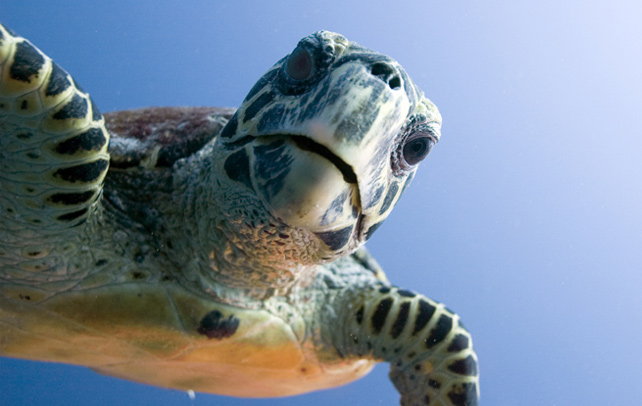Amazing Information On Turtles

Turtles hold great significance, not in the biological world, but even in mythology. The Chinese, for instance, around 2500 B.C., favored a symbol of a snake entwined with a turtle to ward off evil spirits. A legend goes that in the year 456 B.C., the Greek playwright, Aeschylus was killed when a turtle was dropped on his head by an eagle. However, turtles are peaceful and docile companions. Like other reptiles, turtles are ectotherms (cold-blooded), which mean their internal temperature varies depending on their environment. However, leatherback sea turtles have noticeably higher body temperature than surrounding water because of their high metabolic rate. Like other amniotes (reptiles, dinosaurs, birds, and mammals), they breathe air and do not lay eggs underwater, although many species live in and around water. The largest turtles are aquatic. The flesh of turtles is considered a delicacy in a number of cultures. Turtle soup has been a prized dish in Anglo-American cuisine, and still remains so in some parts of Asia. Plenty of such interesting and amazing information on turtles are mentioned in the article below.
Fast Facts
Kingdom: Animalia
Phylum: Chordata
Class: Reptilia
Superorder: Chelonia
Order: Testudines
Suborders: Cryptodira, Pleurodira
Lifespan: Up to 100 years
Amazing Information On Turtles
- Turtles have inhabited this earth for more than 200 million years. They were the first ones to have evolved much before the species of crocodiles, mammals, birds, snakes and even lizards!
- Turtles, unlike tortoises, live in and around water. Some varieties only leave the water to lay eggs. Turtles lay eggs, like other reptiles, which are slightly soft and leathery. The eggs of the largest species are spherical, while the eggs of the rest are elongated. Their albumen is white and contains a different protein from bird eggs, such that it will not coagulate when cooked.
- Turtles can regrow bony and keratin tissue.
- Not all turtles have hard shells. For example, soft-shell turtles and sea turtles have flexible shells.
- Box turtles are not the only turtles with a hinge to allow part of their shell to move.
- Turtle shells are built into their skeleton.
- The shell of a turtle itself is made up of almost 60 different bones, which are connected all together, making it hard and strong. The bony area of the shell is covered with plates known as scutes that are derived from the skin and offer strength and protection.
- Counting the growth rings on the scutes (scales) of the top shell does not tell the age of the turtle or tortoise.
- Some turtles have hinges on their shells to enable them to close up tightly inside.
- Turtles cannot protrude their tongues from their mouths.
- Aquatic turtles have streamlined shells to help them move through the water. They also have webbing between their toes.
- Most of the turtles species have five toes on each limb with a few exceptions including the American Box Turtle of the carolina species which only has four toes and in some cases only three.
- Aquatic turtles have to be in water to eat.
- Turtles can be herbivores (vegetable eaters), carnivores (meat-eaters), or insectivores (insect eaters).
- Many turtles are expert climbers.
- Land turtles’ ears are sensitive to ground vibration.
- A group of turtles is classically called a bale.
- One of the most common health problems is MBD (metabolic bone disease), caused by improper diet and care.
- All turtles do not have the same habitat and nutritional requirements. Therefore, it is very important to research the kind of animal you have or plan to own.
- Turtles have good eyesight, seeing in full color and a strong sense of smell. They have excellent hearing and sense of touch. Their shells have feeling due to nerve endings.
- Turtles are cold-blooded. They require an external heat source. If they get too cool, they can’t digest their food and may hibernate.
- Instead of teeth, turtles have a sharp beak for eating. Depending on species, the beak may be scissor-like, hook-like, or serrated. The earliest turtles did have teeth and could not retract their head.
- Some turtles can live up to a year without food.
- Turtles shed their skin in small flakes rather than pieces like other reptiles.
- Sea turtles can swim up to 35 miles per hour.
- Several species, including the American Box turtle, can have a lifespan of more than100 years.In an extraordinary documentation of an adult Indian Ocean Giant Tortoise, which was captured when it was around 50 years old went on to survive a staggering 152 more years in captivity!
- Some aquatic turtles can absorb oxygen through their skin on their neck and cloacal areas allowing them to remain submerged underwater for extended periods of time and enabling them to hibernate underwater.









